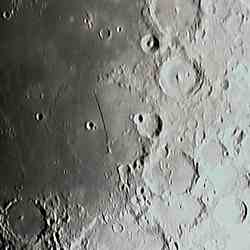
Image credit: Fergal Murphy. Click to enlarge

Image credit: Fergal Murphy. Click to enlarge
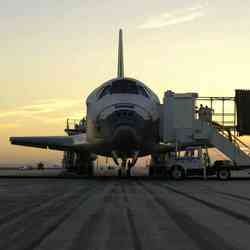
Discovery resting on the runway at Edwards Air Force Base. Image credit: NASA Click to enlarge
The Space Shuttle Discovery is home after a 14-day, 5.8 million-mile journey in space. The mission included breathtaking in-orbit maneuvers, tests of new equipment and procedures, a first-of-its-kind spacewalking repair, and virtual visits with two heads of state.
Commander Eileen Collins and the crew of the STS-114 mission, Jim Kelly, Charlie Camarda, Wendy Lawrence, Steve Robinson, Andy Thomas and Soichi Noguchi of Japan, landed at Edwards Air Force Base, Calif., at 8:12 EDT this morning.
“We have had a fantastic mission,” Collins said shortly after the crew disembarked from the Shuttle. “We brought Discovery back in great shape. This is a wonderful moment for us all to experience.”
Discovery’s mission, the first of two Return to Flight test missions following the 2003 Columbia accident, was one of the most complex space flights in NASA history. The crew flawlessly executed its to-do list.
After an on-time lift-off from KSC on July 26, the crew tested new capabilities and techniques developed over the past two-and-one-half years to inspect and possibly repair the Space Shuttle in orbit. Collins guided Discovery through an unprecedented back flip maneuver as it approached the International Space Station. The maneuver allowed the Station crew to snap high-resolution photos that added to the wealth of new data mission managers used to ensure Discovery was in good shape to come home.
“It’s going to be hard to top this mission,” NASA Administrator Michael Griffin said. “Everywhere you look, there’s nothing but outstanding success.”
Robinson and Noguchi, with the help of crewmates, completed three spacewalks. The astronauts repaired one Space Station Control Moment Gyroscope and replaced another. Their efforts put all four of the Station’s gyros back into service. They also tested new repair techniques for the Space Shuttle’s heat-shielding outer skin and installed equipment outside the Station.
When two thermal protection tile gap-fillers were spotted jutting out of Discovery’s underside, astronauts and other experts on the ground pulled together to devise a plan to prevent the protrusions from “tripping the boundary layer,” causing higher temperatures on the Shuttle during atmospheric re-entry. Ground controllers sent up plans to the Shuttle-Station complex for Robinson to ride the Station robotic arm beneath the Shuttle and, with surgical precision, pluck out the gap-fillers. Work on the Shuttle underbelly had never been tried before, but with Thomas coordinating, Lawrence and Kelly operating the robotic arms, and fellow spacewalker Noguchi keeping watch, Robinson delicately completed the extraction.
Discovery’s astronauts and the Station crew, Russian Sergei Krikalev and American John Phillips, transferred more than 12,000 pounds of equipment and supplies to the Station. Discovery returned about 7,000 pounds of Station material back to Earth.
The crew got phone calls from two world leaders. President George W. Bush and Japanese Prime Minister Junichiro Koizumi offered congratulations and appreciation for all the astronauts’ hard work.
Commander Collins and the crew also paid tribute to the fallen astronauts of Columbia, as well as others who gave their lives for space exploration.
Over the next several weeks, engineers will process data from STS-114, the first of two test missions for the Space Shuttle. Teams are already at work looking into why a large piece of foam fell off the External Tank during ascent. NASA managers have committed to understanding why the foam came off the tank, and remedying it if necessary, before clearing the next Space Shuttle Return to Flight test mission, STS-121, for flight.
The Discovery astronauts will spend the next few days undergoing medical checkouts, reuniting with their families, and returning to Houston. In about a week, after undergoing preparations at Edwards, Discovery will be ferried back to NASA’s Kennedy Space Center, Fla., atop a modified Boeing-747 aircraft.
For more about the Return to Flight mission, visit:
http://www.nasa.gov/returntoflight
Original Source: NASA News Release
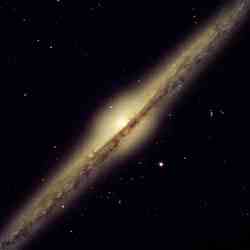
Spiral galaxy NGC 4565. Image credit: ESO Click to enlarge
How does the Galaxy in which we live look like?
It is almost certain that we will never be able to send a probe out of our Milky Way to take a snapshot, in the same way as the first satellites could do to give us striking images of planet Earth. But astronomers do not need this to imagine what our bigger home resembles. And they have a pretty good idea of it.
The Milky Way with its several hundreds of billion stars is thought to be a relatively flat disc -100,000 light-year across- with a central bulge lying in the direction of the constellation Sagittarius (The Archer) and six spiral arms. The Milky Way has most probably also a central bar made of young, bright stars.
If we can’t take pictures of the Milky Way, we may photograph others galaxies which astronomers think look similar to it. The two galaxies presented here are just two magnificient examples of barred spiral galaxies. One – Messier 83 – is seen face-on, and the other – NGC 4565 – appears edge-on. Together, they give us a nice idea of how the Milky Way may appear from outer space.
These images are based on data obtained with the twin FORS1 and FORS2 (FOcal Reducer and Spectrograph) instruments attached to two ESO’s 8.2-m Unit Telescopes of the Very Large Telescope Array located on Cerro Paranal. The data were extracted from the ESO Science Archive Facility, which contains approximately 50 Terabytes of scientific data and is, since April 1, 2005, open to the worldwide community. These invaluable data have already led to the publication of more than 1000 scientific papers. They also contains many nice examples of beautiful astronomical objects which could be the theme of as many midsummer’s dreams.
NGC 4565
The first galaxy pictured here is NGC 4565, which for obvious reasons is also called the Needle Galaxy. First spotted in 1785 by Uranus’ discoverer, Sir William Herschel (1738-1822), this is one of the most famous example of an edge-on spiral galaxy and is located some 30 million light-years away in the constellation Coma Berenices (Berenice’s Hair). It displays a bright yellowish central bulge that juts out above most impressive dust lanes.
Because it is relatively close (it is only 12 times farther away than Messier 31, the Andromeda galaxy, which is the major galaxy closest to us) and relatively large (roughly one third larger than the Milky Way), it does not fit entirely into the field of view of the FORS instrument (about 7 x 7 arcmin2).
Many background galaxies are also visible in this FORS image, giving full meaning to their nickname of “island universes”.
Messier 83
If our Milky Way were to resemble this one, we certainly would be proud of our home! The beautiful spiral galaxy Messier 83 is located in the southern constellation Hydra (the Water Snake) and is also known as NGC 5236 and as the Southern Pinwheel galaxy. Its distance is about 15 million light-years. Being about twice as small as the Milky Way, its size on the sky is 11×10 arcmin2.
The image show clumpy, well-defined spiral arms that are rich in young stars, while the disc reveals a complex system of intricate dust lanes. This galaxy is known to be a site of vigorous star formation.
Original Source: ESO News Release
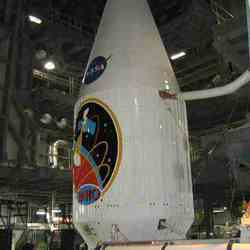
The Mars Reconnaissance Orbiter. Image credit: NASA Click to enlarge
NASA’s Mars Reconnaissance Orbiter is ready for a morning launch on Thursday, Aug. 11. The spacecraft will arrive at Mars in March 2006 for a mission to understand the planet’s water riddles and to advance the exploration of the mysterious red planet.
The mission’s first launch opportunity window is 4:50 to 6:35 a.m. PDT, Thursday. If the launch is postponed, additional launch windows open daily at different times each morning through August. For trips from Earth to Mars, the planets move into good position for only a short period every 26 months. The best launch position is when Earth is about to overtake Mars in their concentric racing lanes around the Sun.
“The teams preparing this orbiter and its launch vehicle have done excellent work and kept to schedule. We have a big spacecraft loaded with advanced instruments for inspecting Mars in greater detail than any previous orbiter, and we have the first Atlas V launch vehicle to carry an interplanetary mission. A very potent and exciting combination,” said NASA’s Mars Exploration Program Director Doug McCuistion.
The mission will lift off from Launch Complex 41, Cape Canaveral Air Force Station, Fla. It is the first government launch of Lockheed Martin’s Atlas V launch vehicle. “We’re ready to fly, counting down through final procedures,” said Chuck Dovale, director for expendable-launch-vehicle launches at NASA Kennedy Space Center, Fla.
When the Mars Reconnaissance Orbiter arrives in March, it begins a half-year “aerobraking” process. The spacecraft will gradually adjust the shape of its orbit by using friction from carefully calculated dips into the top of the Martian atmosphere. The mission?s primary science phase starts in November 2006.
“Mars Reconnaissance Orbiter will give us several times more data about Mars than all previous missions combined,” said James Graf, project manager for the mission at NASA’s Jet Propulsion Laboratory, Pasadena Calif.
Researchers will use the data to study the history and distribution of Martian water. Learning more about what has happened to the water will focus searches for possible past or present Martian life. Observations by the orbiter will also support future Mars missions by examining potential landing sites and providing a communications relay between the Martian surface and Earth.
The craft can transmit about 10 times as much data per minute as any previous Mars spacecraft. This will serve both to convey detailed observations of the Martian surface, subsurface and atmosphere by the instruments on the orbiter and enable data relay from other landers on the Martian surface to Earth. NASA plans to launch the Phoenix Mars Scout in 2007 to land on the far northern Martian surface. NASA is also developing an advanced rover, the Mars Science Laboratory, for launch in 2009.
The mission is managed by JPL, a division of the California Institute of Technology, Pasadena, Calif., for the NASA Science Mission Directorate. Lockheed Martin Space Systems, Denver, built the spacecraft and is the prime contractor for the project.
NASA’s Launch Services Program at the Kennedy Space Center is responsible for government engineering oversight of the Atlas V, spacecraft/launch vehicle integration and launch day countdown management.
For more information about the Mars Reconnaissance Orbiter on the Web, visit: http://www.nasa.gov/mro.
Original Source: NASA News Release
Saturn’s moon Epimetheus just beneath the ring. Image credit: NASA/JPL/SSI Click to enlarge.
Saturn’s moon Epimetheus is seen here from just beneath the ring plane, along with Saturn’s intriguing F ring. The bright, knotted core of the F ring is flanked on both sides by thin, dusty strands. The outer part of the A ring is visible at the left. Epimetheus is 116 kilometers (72 miles) across.
Part of the little moon’s night side is illuminated by reflected light from the planet. For a closer view of Epimetheus see Epimetheus: Up-Close and Colorful.
The image was taken in visible light with the Cassini spacecraft narrow-angle camera on June 30, 2005, at a distance of approximately 1.8 million kilometers (1.1 million miles) from Epimetheus and at a Sun-Epimetheus-spacecraft, or phase, angle of 93 degrees. Resolution in the original image was 11 kilometers (7 miles) per pixel.
The Cassini-Huygens mission is a cooperative project of NASA, the European Space Agency and the Italian Space Agency. The Jet Propulsion Laboratory, a division of the California Institute of Technology in Pasadena, manages the mission for NASA’s Science Mission Directorate, Washington, D.C. The Cassini orbiter and its two onboard cameras were designed, developed and assembled at JPL. The imaging operations center is based at the Space Science Institute in Boulder, Colo.
For more information about the Cassini-Huygens mission visit http://saturn.jpl.nasa.gov . The Cassini imaging team homepage is at http://ciclops.org .
Original Source: NASA/JPL/SSI News Release

Looking down on Earth. Image credit: NASA Click to enlarge
A number of hypotheses have been used to explain how free oxygen first accumulated in Earth’s atmosphere some 2.4 billion years ago, but a full understanding has proven elusive. Now a new model offers plausible scenarios for how oxygen came to dominate the atmosphere, and why it took at least 300 million years after bacterial photosynthesis started producing oxygen in large quantities.
The big reason for the long delay was that processes such as volcanic gas production acted as sinks to consume free oxygen before it reached levels high enough to take over the atmosphere, said Mark Claire, a University of Washington doctoral student in astronomy and astrobiology. Free oxygen would combine with gases in a volcanic plume to form new compounds, and that process proved to be a significant oxygen sink, he said.
Another sink was iron delivered to the Earth’s outer crust by bombardment from space. Free oxygen was consumed as it oxidized, or rusted, the metal.
But Claire said that just changing the model to reflect different iron content in the outer crust makes a huge difference in when the model shows free oxygen filling the atmosphere. Increasing the actual iron content fivefold would have delayed oxygenation by more than 1 billion years, while cutting iron to one-fifth the actual level would have allowed oxygenation to happen more than 1 billion years earlier.
“We were fairly surprised that we could push the transition a billion years in either direction, because those levels of iron in the outer crust are certainly plausible given the chaotic nature of how Earth formed,” he said.
Claire and colleagues David Catling, a UW affiliate professor in atmospheric sciences, and Kevin Zahnle of the National Aeronautics and Space Administration’s Ames Research Center in California will discuss their model tomorrow (Aug. 9) in Calgary, Alberta, during the Geological Society of America’s Earth System Processes 2 meeting.
Earth’s oxygen supply originated with cyanobacteria, tiny water-dwelling organisms that survive by photosynthesis. In that process, the bacteria convert carbon dioxide and water into organic carbon and free oxygen. But Claire noted that on the early Earth, free oxygen would quickly combine with an abundant element, hydrogen or carbon for instance, to form other compounds, and so free oxygen did not build up in the atmosphere very readily. Methane, a combination of carbon and hydrogen, became a dominant atmospheric gas.
With a sun much fainter and cooler than today, methane buildup warmed the planet to the point that life could survive. But methane was so abundant that it filled the upper reaches of the atmosphere, where such compounds are very rare today. There, ultraviolet exposure caused the methane to decompose and its freed hydrogen escaped into space, Claire said.
The loss of hydrogen atoms to space allowed increasingly greater amounts of free oxygen to oxidize the crust. Over time, that slowly diminished the amount of hydrogen released from the crust by the combination of pressure and temperature that formed the rocks in the crust.
“About 2.4 billion years ago, the long-term geologic sources of oxygen outweighed the sinks in a somewhat permanent fashion,” Claire said. “Escaping to space is the only permanent escape that we envision for the hydrogen, and that drove the planet to a higher oxygen level.”
The model developed by Claire, Catling and Zahnle indicates that as hydrogen atoms stripped from methane escaped into space, greenhouse conditions caused by the methane blanket quickly collapsed. Earth’s average temperature likely cooled by about 30 degrees Celsius, or 54 degrees Fahrenheit, and oxygen was able to dominate the atmosphere because there was no longer an overabundance of hydrogen to consume the oxygen.
The work is funded by NASA’s Astrobiology Institute and the National Science Foundation’s Integrative Graduate Education and Research Traineeship program, both of which foster research to understand life in the universe by examining the limits of life on Earth.
“There is interest in this work not just to know how an oxygen atmosphere came about on Earth but to look for oxygen signatures for other Earth-like planets,” Claire said.
Original Source: UW News Release
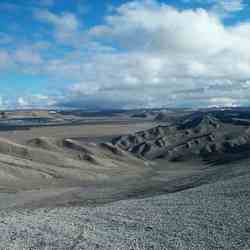
Hills of impact melt breccias. Image credit: Gordon Osinski/CSA Click to enlarge
Meteor impacts are generally regarded as monstrous killers and one of the causes of mass extinctions throughout the history of life. But there is a chance the heavy bombardment of Earth by meteors during the planet’s youth actually spurred early life on our planet, say Canadian geologists.
A study of the Haughton Impact Crater on Devon Island, in the Canadian Arctic, has revealed some very life-friendly features at ground zero. These include hydrothermal systems, blasted rocks that are easier for microbes to inhabit, plus the cozy, protected basin created by the crater itself. If true, impact craters could represent some of the best sites to look for signs of past or present life on Mars and other planets.
A presentation on the biological effects of impacts is scheduled for Monday, 8 August, at Earth System Processes 2, a meeting co-convened by the Geological Society of America and Geological Association of Canada this week in Calgary, Alberta, Canada.
The idea that meteor impacts could benefit or even create conditions suitable for the beginning of early life struck Canadian Space Agency geologist Gordon Osinski while he and colleagues were conducting a geological survey of the 24-kilometer (15-mile) diameter Haughton Crater. Along the rim of the crater they noticed what looked like fossilized hydrothermal pipes, a few meters in diameter.
“That set the bells ringing about possible biological implications,” said Osinski. Hydrothermal systems are thought by many people to be the favourable places for life to evolve.”
Detailed mineralogical analyses have since revealed that when the Haughton meteor smacked into the icy ground 23 million years ago it created not only a crater, but fractured the ground in such a way as to create a system of steamy hydrothermal springs reaching temperatures of 250 degrees C. The heat appears to have gradually dropped over a period of tens of thousands of years, the researchers report.
Besides providing heat and cracking the ground, the impact also created pore spaces in otherwise dense granitic rocks, giving microbes more access to the minerals and the surfaces inside the rocks ? basically more real estate and more supplies.
The shocked rocks are also more translucent, which would be beneficial to organisms that possessing with any photosynthetic capabilities.
A crater shape itself also might serve as a protective environment, says Osinski. As such, impact craters are also good places to store evidence of past life. On Earth many craters fill with water and become lakes. Lakes accumulate sediments, the layers of which are a geological archive of the time after the crater formed. The Haughton Impact crater, for instance, contains the only Miocene-age sediments in the entire Canadian Arctic.
“One of the most interesting aspects of the Haughton Impact Crater is that it’s in a polar desert,” said Osinski. The dry, frigid weather makes for a barren landscape that’s easy to study, he said. The same features make it one of the more Mars-like places on Earth.
“Most people put impacts with mass extinctions,” said Osinski. “What we’re trying to say is that following the impact, the impact sites are actually more favorable to life than the surrounding terrain.”
It’s interesting to note, says Osinski, that on Earth the heaviest meteor bombardment of the planet happened at about the same time as life is believed to have started: around 3.8 billion years ago. Impact craters of that age were long ago erased on Earth by erosion, volcanic resurfacing and plate tectonics.
But other planets and moons – including Mars – still bear the cosmic scars of that early debris-clogged period in the solar system. It may be possible, therefore, that the best places to look for at least fossil evidence of life on Mars is inside those very same craters, he said.
“What we’re doing is trying to narrow down the search area,” said Osinski.
Original Source: GSA News Release
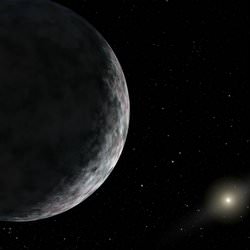
Artist illustration of the newly discovered 10th planet. Image credit: NASA/JPL. Click to enlarge.
At the same time, another team led by astronomer Mike Brown of Caltech reported they had been observing 2003 EL61 for almost a year, but were waiting to analyze data from the Spitzer Space Telescope before announcing the discovery.
“There is no question that the Spanish group is rightly credited with discovery,” Brown stated on his personal website. “Even if they had found the object only this year and announced its existence, they would still be considered the rightful discovers. We took a chance that no one else would find it while we were awaiting our observations from the Spitzer Space Telescope. We were wrong! And we congratulate our colleagues on a very nice discovery.”
But just hours after that, Brown announced to the media the discovery of two other big TNOs, designated as 2003UB313 and 2005 FY9. Regarding the first one, he stated that it’s about three times as far from the Sun as Pluto, and “it’s definitely bigger” than the ninth planet.
Brown’s team discovered 2003 ub313 on January 8th, but wanted to further analyze their observations. However, they “were forced to announce their results on Friday evening because word had leaked out” he said.
“In mid-July, short abstracts of scientific talks to be given at a meeting in September became available on the web. We intended to talk about the object now known as 2003 EL61, which we had discovered around Christmas of 2004, and the abstracts were designed to whet the appetite of the scientists who were attending the meeting. In these abstracts we call the object a name that our software automatically assigned, K40506A -the first Kuiper belt object we discovered in data from 2004/05/06, May 6th-. Using this name was a very very bad idea on our part.”
“Unbeknownst to us, some of the telescopes that we had been using to study this object keep open logs of who has been observing, where they have been observing, and what they have been observing. A two-second Google search of “K40506A” immediately reveals these observing logs”.
According to Brown, from the moment the abstracts became public, anyone with an Internet connection and a little curiosity about the “K40506A” object could have found out where it was.
Brown was quick to point that he believes the fact that this discovery happened days after the data were potentially available on the Web is a coincidence. But “some people in the community privately expressed their concerns to me that this coincidence was too good to be true and wanted to know if there was any possible way that anyone could have found out the location of our object,” he added.
At this point, Brown contacted Brian Marsden at the International Astronomical Union’s Minor Planet Center (MPC). Brown told him confidentially about the two objects not yet announced (2003 UB313 and 2005 FY9), expressed his concerns that someone might be able to find their data and attempt to claim credit for discovering these objects, and sought advice.
Marden found that someone had already used the website of the MPC to access past observations of one of the objects and predict its location for that night. The past observations were precisely the logs from the telescope that Brown’s group had been using. “We had no choice but to hastily pull together a press conference which was held at 4pm on the last Friday in July, perhaps the single best time to announce news that you want no one to hear”, said Brown.
However, some astronomers have a very different opinion about Brown’s announcement.
“The group of Dr. Brown decided, as in previous cases, not to make public its detection until they finished their observations and their research work, and until the object was in conjunction with the Sun so that other people couldn’t observe it,” stated Dr. Javier Licandro in an e-mail sent to a Spanish-speaking astronomy mailing list. Licandro works at the Isaac Newton Group of Telescopes and the Instituto de Astrof?sica de Canarias, in Spain.
“They did it before with Sedna. But this time, by taking this ‘doubtful’ risk, they lost all the rights on the discovery of that object. Even more, their policy is, at least, criticizeable.”
“Due to the detection of 2003 EL61 by Ortiz et. al., and because of the fiasco that this has represented for Brown et. al., they decided to go public ‘ipso factum’ with their discoveries of two other objects that they knew at least from six months ago, 2005 FY y 2003 UB313,” said Licandro.
Contacted by AstronomiaOnline.com, Brown wouldn’t want to elaborate on Licandro’s comments. “I like Javier. It is unfortunate he feels the need to make such remarks,” he said.
But it didn’t take long for Ortiz to air his own feelings about the situation. “With technology many times more advanced than our own, Brown’s team had discovered three big objects many months ago, but they were hiding their findings from the international scientific community, as they did before with Quaoar and Sedna,” he declared to the Spaniard paper ABC.
“This secrecy was useful to Brown, as it allowed him to study the object in detail and exclusively. But his actions harm science and don’t follow the established procedures that imply notifying the existence of a new object to the astronomical community as soon as it’s discovered,” added Ortiz.
Brown indicated that he didn’t get that statement from Ortiz himself, so he would not want to comment on it directly. However, asked again by AstronomiaOnline.com, he said: “In general, there certainly are people who have that opinion, to which they are entitled. I, however, cannot think of any area of science in which an ‘established procedure’ is to announce a discovery with no time for thought and analysis. Anyone who feels otherwise is welcome to go and find these objects themselves -as did Ortiz- and get the credit for their own discoveries.”
Written by Ricardo J. Tohmé for Astronom?aOnline. If you want to read the original article in Spanish, click here.
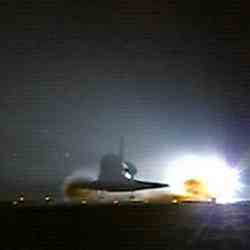
Discovery’s touchdown. Image credit: NASA Click to enlarge
Discovery glided to a pre-dawn landing at Edwards Air Force Base in California this morning concluding a journey of 5.8 million miles, touching down at 7:11 a.m. CDT.
The landing marked the sixth night landing at Edwards Air Force Base, and the 50th time overall that a Shuttle concluded its mission in the California desert.
Commander Eileen Collins and Pilot Jim Kelly, assisted by Mission Specialist Steve Robinson, began Discovery?s return to earth by firing the spacecraft’s orbital maneuvering system engines to slow its speed and begin its descent. Discovery’s ground track took it from the firing of the 2 minute, 42-second deorbit burn at 6:06 a.m. over the western Indian Ocean, traveling in a loop around Australia, then northeast across the Pacific, across the California coast north of Los Angeles and then to Edwards.
Persistent thunderstorms at the primary landing site in Florida resulted in a wave-off of two opportunities to return to the launch site today.
The STS-114 flight of Discovery with Collins, Kelly, Robinson and Mission Specialists Soichi Noguchi of the Japanese Aerospace Exploration Agency, Andy Thomas, Wendy Lawrence and Charlie Camarda provided unprecedented information on the condition of an orbiter in space. Noguchi and Robinson did three successful spacewalks at the International Space Station and Discovery transported tons of equipment and supplies to and from the Station.
From the Station, Commander Sergei Krikalev and NASA Science Officer John Phillips sent their congratulations to Discovery?s crew and the flight control team in Houston.
Discovery?s crew will have a welcome home ceremony at 3 p.m. Wednesday at Houston?s Ellington Field.
Original Source: NASA News Release
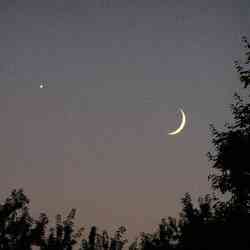
Image credit: Brad Timerson. Click to enlarge